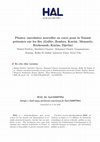Papers by El Mokni El Mokni
Botanica, Dec 31, 2022
Three taxa of macromycetes, Otidea alutacea, Otidea bufonia and Phylloscypha phyllogena, were fir... more Three taxa of macromycetes, Otidea alutacea, Otidea bufonia and Phylloscypha phyllogena, were first recorded in Tunisia. Occurrences of Humaria hemisphaerica and Peziza vesiculosa were confirmed from the northwestern part of Tunisia more than 100 years after their first records in the northeast and the southwestern parts of the country, respectively. The species reported belong to three families of the Pezizales order (Otideaceae, Pezizaceae and Pyronemataceae). Short descriptions of their distinctive macroscopic and microscopic features, ecology and geographical distribution in Tunisia are given. The locality, the data of collection and field photographs for each species are also presented.

Flora Mediterranea, 2020
Vascular plants new or rare for Tunisia occurring on the islands (Galite, Zembra, Kuriat, Monasti... more Vascular plants new or rare for Tunisia occurring on the islands (Galite, Zembra, Kuriat, Monastir, Kerkennah, Kneiss, Djerba).-This study concerns the indigenous vascular plants newly reported for Tunisia and discovered on the islands during some field trips performed since 2014. Five native taxa are new to Tunisia: Bellis perennis, Carthamus creticus, Moraea mediterranea, Asplenium balearicum and Galium minutulum, the latter two also being new to North Africa. Information on 24 rare or poorly known taxa, most often of great biogeographical interest, is given, too. Most of these were discovered on the islands of the eastern coast (Kuriat, Monastir, Kerkennah, Kneiss, Djerba), but also on the northern islands of Zembra and La Galite. The new chorological data underline the first-rate conservation importance of these islands and islets for the preservation of the overall coastal biodiversity of Tunisia.







Uploads
Papers by El Mokni El Mokni